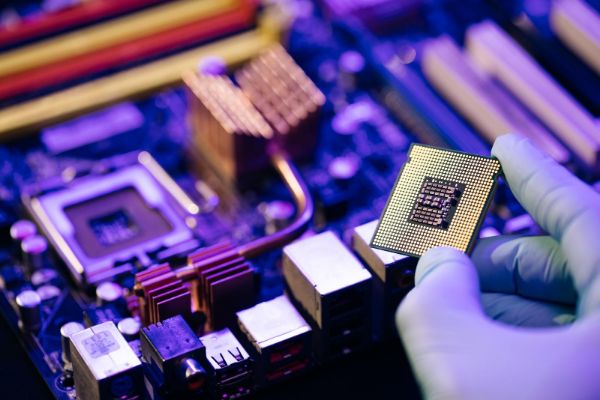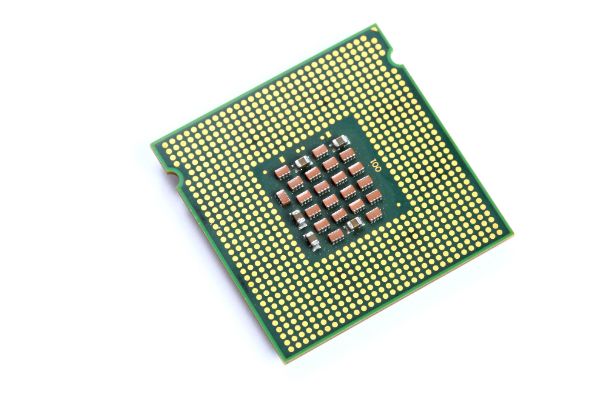Disclaimer: This post may contain affiliate links, meaning we get a small commission if you make a purchase through our links, at no cost to you. For more information, please visit our Disclaimer Page.
As technology advances, CPUs (central processing units) are getting smaller and faster. But why are they making them so small? What are the pros and cons of having a big or small CPU? In this blog post, we will explore the reasons behind why CPUs are shrinking, and discuss the advantages and disadvantages of both large and small processors. Stay tuned!
A larger CPU means more transistors and more space for caches, which would lead to a significant performance increase. However, the downside is that it would be much harder to cool such a large CPU, and it would also require more power.
So there are many challenges involved in making CPUs physically bigger, which is why they have remained about the same size for so many years.
There are several reasons CPUs haven’t gotten any bigger over the years. It’s becoming increasingly difficult to fit more transistors onto a chip without causing overheating problems. Additionally, larger CPUs would require more power, and cooling them down becomes much more challenging.
All of these factors mean that there are some serious design challenges involved in creating a physically larger CPU.
While a larger CPU would offer some significant performance improvements, the challenges involved mean that it’s not likely to happen anytime soon. However, as processors continue to get more and more powerful, it may eventually become necessary to move in this direction.
Table of Contents
Does CPU Size Affect Performance?
The size of a CPU also affects its performance. The larger the CPU, the more transistors it has and the faster it can process information. This is why high-end CPUs are typically large in size. However, there is a limit to how large a CPU can be before it becomes too difficult to manufacture.
One way to improve the performance of a CPU is to increase the number of cores. This is because more cores can process information faster than a single core. However, not all applications can take advantage of multiple cores.
Some applications are designed to only use a single core. So, if you have a multi-core CPU and an application that only uses one core, the other cores will be idle and not doing anything.
Another way to improve the performance of a CPU is by increasing its clock speed. The higher the clock speed, the faster it can process information. However, there is also a limit to how fast a CPU can run before it becomes too hot and starts to overheat. So, most CPUs have a maximum clock speed that they can run at.
Thus it is evident that CPU size, number of cores, and clock speed all affect the performance of a CPU. How well a CPU performs depends on the type of application that is being run and how well it is designed to take advantage of multiple cores or a high clock speed.
Simply increasing the size of the CPU is not always the answer to improving performance.
What Is Moore’s Law, and Why Does It Matter for CPUs?
Moore’s law is simply an observation. It was discovered by Gordon Moore in 1965. He noticed that the number of transistors on a chip would double every year. This led to exponential growth in integrated circuit density, which put more power into less space with each passing year at lower costs.
You can see this when you look at old computers like those from the 1980s and 1990s compared to modern computers today. The CPU inside these older computers had far fewer transistors than what we have now, so they were able to do much less processing compared to even low-end CPUs today.
Moore’s law has been critical in allowing for the exponential growth of computing power we have seen over the past few decades. It is responsible for making our smartphones, tablets, and laptops so powerful while also becoming increasingly affordable.
If one were to reduce the cost of a CPU while increasing its performance, it would be possible to put more computing power into more devices and make them affordable for even the most economically disadvantaged.
This would mean that almost everyone in the world could have access to a computer, which would allow them to participate in a modern technological society.
Unfortunately, Moore’s law is not going to last forever. There are physical limits on how small transistors can be made and how many of them can fit into an integrated circuit before they start interfering with each other’s performance or heat up too much for electronics inside it to work properly.
This would eventually lead to restricting how small a CPU would get.
Larger CPUs are Expensive and Difficult to Produce
While smaller CPUs may eventually hit a physical limit, that does not mean that larger CPUs will stop getting better. In fact, the opposite is true. Larger CPUs are able to do more processing due to their increased number of transistors, but they come with two major downsides.
First, large CPUs are expensive to produce because they require more materials and time to manufacture. This means that the end-user pays more for them when they eventually become available on the market.
Second, large CPUs are difficult to cool down, which can create problems in laptops and other small devices where there is limited space for airflow. Overheating can cause permanent damage to electronic components if it is not prevented.
Both of these factors have led to a slowdown in the rate of increase for transistor density on chips.
The shift from single-core processors to multi-core processors has also helped alleviate some of these issues by allowing CPUs with larger numbers of transistors not to overheat and consume too much power when running at full capacity.
This allows them to be used more efficiently than if they were just one large CPU that could only run on its own without sharing resources between multiple cores or threads simultaneously (i.e., multithreading).
Larger Dies are Not Always Better
As discussed above, larger CPUs have a lot of benefits, but they come with downsides as well.
If we only looked at transistor density, then the largest dies would always be better than smaller ones because more transistors mean more performance and efficiency for any given task (which is usually true). However, this ignores several other factors that make it difficult to develop large die chips in practice.
One issue is cooling. When you have a chip that has many cores on it or just one really big core, there will be hotspots where these cores get hot during use because of their high power consumption; therefore if your system doesn’t have good cooling then those areas will get even hotter and cause thermal throttling which makes them slow down or stop working temporarily until they cool back off again.
Another issue is manufacturing defects; a larger die is more likely to have a higher percentage of defective chips than a smaller die because of the increased complexity and number of layers in the manufacturing process.
This can lead to yield issues where only a fraction of the chips produced are actually usable, which drives up the cost per chip and makes it difficult for companies to produce large CPUs at scale.
Pros and Cons of a Big CPU
This is essentially a quick summary of some points made above.
Pros
A big CPU is great for the following reasons:
- Increased Transistor Density for More Performance and Efficiency
- More Cores and Threads for Multitasking
Cons
However, a big CPU also has the following downsides:
- Large CPUs are expensive to produce because they require more materials and time to manufacture. This means that the end-user pays more for them when they eventually become available on the market.
- Large CPUs are difficult to cool down, which can create problems in laptops. There could also be cooling issues if used in builds with limited airflow.
- Manufacturer Yield Issues Can Reduce Overall Productivity
- Thermal Throttling Can Cause Chips to Slow Down or Stop Working Temporarily.
Why Are CPUs Getting Smaller?
In the world of computing, things are constantly changing. While there will always be a need for bigger and better processors running at higher clock speeds with more cores, there’s also a demand to shrink them down in size – not just because it means they take up less space but also because it saves power.
This is particularly important when designing chips specifically for mobile devices like smartphones or tablets where battery life matters most.
A few reasons why CPUs are getting smaller are:
Expensive:
When you have a lot of transistors in your chip, it means the cost of manufacturing each one is less. There is also a limited amount of resources on Earth that manufacturers are competing for.
A smaller chip is more economically viable for a company to produce in the long term.
Power:
The smaller the circuit, the lower the power consumption – and therefore heat generation.
Speed:
If there are fewer components on your chip, they’ll be closer together, resulting in faster communication between them.
Die size:
A smaller die means more chips can fit on a wafer, so you get more for your money.
Practicality:
In many cases, like mobile devices or embedded systems, you don’t need huge amounts of computing power because they are usually performing specific tasks and not running exhaustive computations all day long.
But that doesn’t mean we should use smaller chips everywhere, however; more often than not, it makes sense to use bigger processors for big jobs where battery life isn’t an issue!
Power savings:
A large chip will consume more power than a smaller one. This is because the bigger size means there are many transistors packed together which require voltage to be switched on or off.
Smaller chips allow for lower voltages which in turn reduces power consumption and heat dissipation problems; this makes them ideal candidates when designing products like laptops and other portable electronics.
So what does this mean for us? Well generally speaking there are three main benefits that come with smaller CPUs: less cost (since it takes fewer materials), better performance (because we can fit more transistors into each square millimeter of space), and lower power consumption levels.
Final Thoughts
We have many reasons to believe in the future of smaller CPUs, including cost-effectiveness and better performance. However, there are also downsides such as more heat dissipation problems or slower clock speeds needed for high-end tasks like gaming.
As we move into an increasingly mobile world, the trend for smaller and more power-efficient CPUs is only going to continue. While there will always be a need for high-performance processors in areas like data centers and gaming, the market for small, low-power chips is growing exponentially which is good news for us consumers!
Additional Reading:



